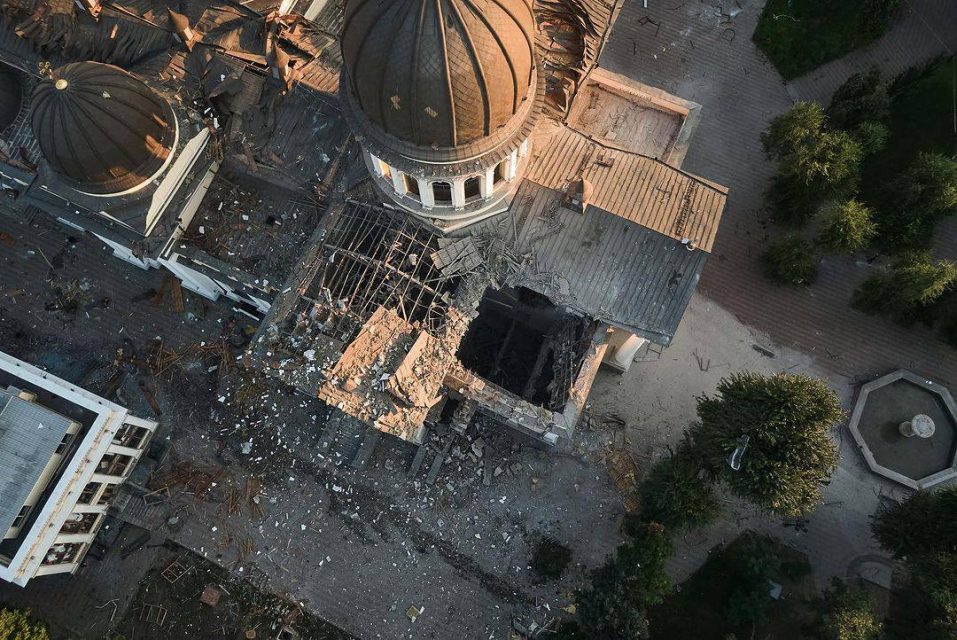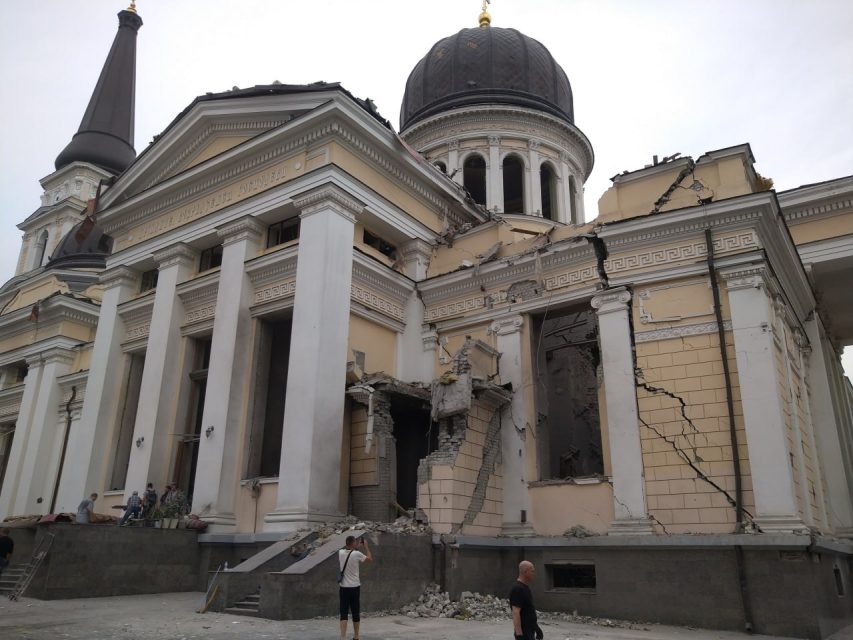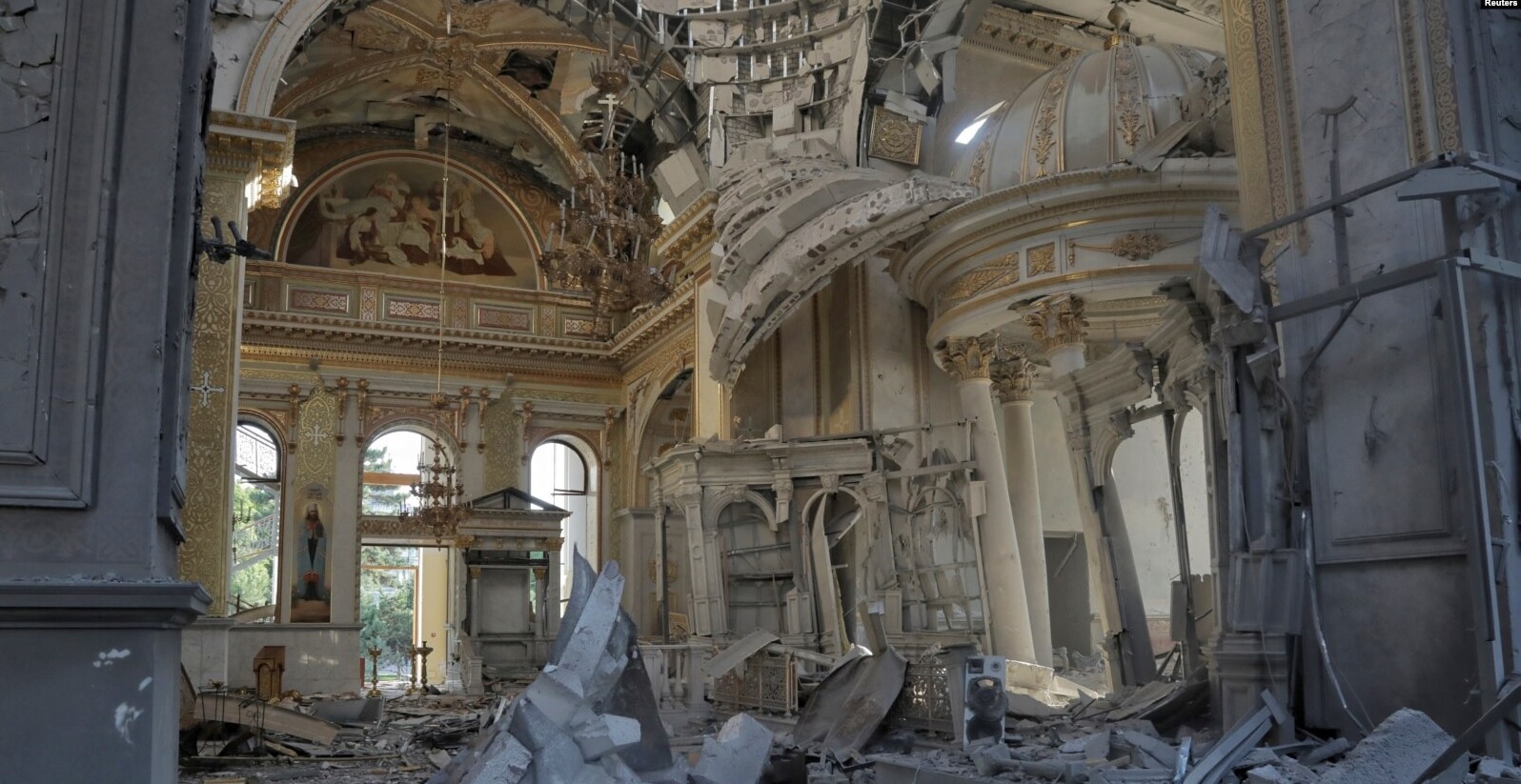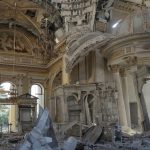Author – Roman Malko
site-partner
During the latest explosions, the occupiers damaged several historic buildings associated with the French presence and cultural influence.
Odessa was regularly bombed from the first days of the war. But this time the bombing really looks like a brazen demonstration. On the night of July 19-20, 2023, Russia openly and clearly bombed the historic center of the city. During this terrible massive rocket attack, 23 monuments of history were damaged. Not to mention other buildings, such as schools, kindergartens, and residential buildings. The rocket, which was not intercepted by Ukrainian air defense systems, hit an ordinary office building at the beginning of Kanatna Street. The consequences of the explosion were terrible. The blast wave was so strong that objects were damaged even on Prymorskyi Boulevard, two kilometers from the epicenter of this shooting. The next day, on the night of July 23, the bombing of the city center was repeated with even more serious consequences: 27 objects of cultural heritage were destroyed.
The Kremlin’s demonic propagandists did not hide their joy at the crime committed by their military. They proudly commented on the bombing, calling for ever more massive attacks, threatening to completely destroy the city. All this was broadcast on Russian central TV channels, which means that the authorities gave their approval. It is worth mentioning that nothing can be communicated in Russia without the agreement of the Kremlin.
The center of Odesa, like the port, is included in the UNESCO World Heritage List, and Russia as a member of this organization, is obliged to follow the rules of UNESCO. However, even this fact did not stop the aggressor. Is it possible to demand that terrorists keep their promises? Unfortunately, less than a month later, on the night of August 14, the center of Odesa again suffered from a massive rocket and drone attack. This time, over two hundred buildings were damaged.
In the last year and a half of the war in Ukraine, there are no large cities that have not been hit by a Russian missile or a deadly drone, and some are the targets of particular stubbornness. And not only because they have great strategic or military importance. Almost every point on the map where the enemy tries to strike is strategic because it has military units, the National Guard, police, and the SBU, and every city has critical infrastructure.
However, there are specific targets that the Russians seem to be able to hit endlessly as if to compensate for their childhood trauma. And it is not only about Kyiv, the city of their shame and humiliation. They promised to occupy the city in three days, but it hindered Russian narratives. The pearl of the Black Sea, Odesa, which the invaders also failed to capture, is their special pain. And the regular bombing of the historical center, aimed at its destruction, only shows that this pain is becoming more and more unbearable for them.

Last year, when the war was in full swing, Putin, speaking at the Valdai Forum, called Odesa
one of the most beautiful cities in the world, founded by the Russian empress Catherine II. As usual, he lied. Odesa is indeed very beautiful, but it appeared on the world map long before Catherine and Muscovites set foot on its streets. Back in the fifth century BC, in the place of the modern center of Odesa, there was a former Greek colony – the Istrian Harbor. The remains of this colony were discovered under the current Prymorskyi Boulevard, in the center. This colony was only one element of the great ancient Greek civilization that reached the shores of the Black Sea. The cities of Thira, Borysphenida, and Olbia flourished nearby.
The first written mention of Odesa dates back to 1415. At that time, the city was called Khadjibey. It was founded by the nobleman of Podillia Kocub Jakuszynski, with the blessing of Vytautas, the ruler of the Grand Duchy of Lithuania. In the very beginning, it was a fortress with a commercial dock. After the arrival of the Ottomans in 1540, the city adopted the name of Khadjibey, and Catherine II annexed it to her empire only in 1794. And even this she managed with the help of the Ukrainian Cossacks.
All this long and glorious history does not prevent Putin and the Russians from considering Odesa as an “authentically Russian” city and again dreaming about its annexation. Until they destroy the city from the map if they cannot take it. And this is quite typical for the Russian state: to leave behind scorched land, killed people, destroyed memory…
After all, despite Putin’s naive expectations, Odesa does not want to become a backup option for his “Russian peace”. Even if the majority of the population of this city today speaks Russian, due to disputed historical circumstances, this does not mean anything. This unique Ukrainian city has always been, above all, a city of freedom. Freedom flows in the blood of Odesa citizens and no government has been able to stifle it. Odesa has always been multicultural. It is a city, which consists of many nationalities that have always happily coexisted with each other. Today it is even difficult to say with certainty who created Odesa as it is. It is difficult to say which nations contributed more or less to its prosperity. This city was created by all those who lived there: Ukrainians, Greeks, Jews, Armenians, Moldovans, Bulgarians, French, Germans, Italians, Poles…
For example, the first mayor of the city was the Frenchman Armand-Emmanuel-Sophie-Septimanie de Vignerot du Plessis, Duke of Richelieu, who twice served as prime minister of France after returning to his country of origin. The period of his rule in Odesa remained in memories as a period of unprecedented development. Richelieu Street, Richelieu High School, Duke Park, and a monument are named after him. Duke Richelieu was succeeded as mayor by the British Thomas Cobley, whose name is given to the famous Ukrainian seaside resort and the equally famous Koblevo brand of Ukrainian wines. Then Odesa was ruled again by the Frenchman Alexandre-Louis Andrault de Langeron, who continued the work of Richelieu and received the status of a free port for Odesa. It ensured the real prosperity of the city for many decades. Without the Frenchman Francois-Paul Sainte de Wollant, the city of Odesa could be completely different today. He developed a city plan. He invented a network
of streets, which successfully fit into the contour of the arch of Odesa Bay, and drew the main urban centers of the future city.

It should be noted that during the recent bombings by the Russians, many historical buildings created by architects of various nationalities were damaged. Most of them were created by Italian architects, but there are also monuments created by French, German, and Dutch specialists. For example, the building of the English Club, not far from the town hall, which houses the Maritime Museum, was built in 1842 by the architect Giorgio Torricelli. This is one of the important architectural monuments that form the traditional atmosphere of the historical center of the city. However, the Russians are not interested in this. By bombing the city, they are deliberately destroying its true face, multiculturalism, and colors. Indeed, they cannot help but know that they are endangering unique historical monuments. Odesa is a compact city where everything is nearby, from the port to the harbor and the historical center. For a missile, the distance is very short. And here Russia’s crime is obvious.
The Odesa Literary Museum is located near the English Club. It is located in a luxurious palace complex, on Lanzheronivskyi Uzviz, designed by the famous French architect Louis César Otto. His drawings were also used for the construction of the palace of the rich merchant Abaza (now the Museum of Western and Oriental Art) and the palace of another merchant Marazli. Otto also designed the palace of Count Tolstoy, near the Sabaney Bridge, which now houses the House of Scientists. During the bombing, this unique monument was also seriously damaged by an explosion that occurred at Viiskovyi Uzviz, 18. The explosion destroyed its summer garden located in the courtyard, broke almost all the ancient stained glass windows of the building, damaged the furniture and the luxurious interior of the nineteenth century. The security guard of the restaurant in the garden was killed instantly by the fragments of a rocket.
Directly across the street from the House of Scientists is the Hotel Pommer, a very elegant home of a French family. Pommers were bankers. Antony Pommer was the first Frenchman who settled in Odesa at the beginning of the 19th century. This house was built in 1894 by his grandson, Andre Pommer, a well-known financier and philanthropist of Odesa. The mansion was heavily damaged by the shock wave, many windows were broken, but fortunately, it survived. Like the large Von Deschie house next door, built in the Art Nouveau style and which once housed the French consulate.
However, the Transfiguration Cathedral on Cathedral Square was the most affected. Its story is a good illustration of the history of the city. It was designed at different times by Dutchman Vincent Vanrezant, Italian Giovanni Frapolli, and German Deolaus-Heinrich Heidenreich. This is a restored monument. In the 1930s, the communists blew up the cathedral and erected a monument to the glory of Joseph Stalin in its place. In independent Ukraine, the church was restored and rebuilt as it looked before the destruction. Ironically, the rebuilt cathedral was blessed in 2010 by Patriarch Kyrylo Gundyaev, the head of the
Russian Orthodox Church, who today blesses the Russians for killing Ukrainians.
“This was not the first bombing of Odesa, but the historical center became the object of such targeted attacks for the first time,” said Fedir Stoianov, deputy director of the department and head of the department for work with UNESCO and cultural heritage protection. “These are very painful blows to the city. This is really our historical center, which we are very proud of, as well as that the world has recognized and included it in the UNESCO World Heritage List. The rocket deliberately hit the Orthodox cathedral. There is a large square near the cathedral, and there is not the slightest military installation in this place. This is a residential area, the heart of our city. The shots are very precise as if to show power and mock the whole civilized world, UNESCO, to show that “we don’t care, we do what we want to do”…
Air Force spokesman Yurii Ihnat notes that the missiles used by the Russians to attack Ukraine are not particularly accurate. For example, missiles from the coastal system “Bastion” such as “Onyx”, and X-22 – air-launched cruise missiles were used to strike the sea coast, in this case, the city of Odesa. “As you know, these two missiles are not very accurate,” – Ihnat insists. “But, unfortunately, they cannot be destroyed today. We can’t do that. The X-22 is a cruise missile, but it attacks at high speed, more than 4,000 kilometers per hour, and it attacks the target with ballistics. Therefore, its speed and flight path do not allow to destroy it in the air by conventional means.” Only Patriot systems could shoot down such missiles, but Ukraine does not have enough of them.
The question of whether the Russians wanted to destroy the historic center of the city, which is on the UNESCO World Heritage list, is debatable. “Only those who launch the missiles can know. However, whether they want it or not doesn’t matter. The simple fact of using such weapons in densely populated cities is already a crime against humanity. X-22 missiles or Onyx missiles, which have a shock error of 600 meters, are designed to destroy groups of aircraft carriers with a tactical nuclear warhead. This weapon was used more than once. More than 150 X-22 missiles were launched on the territory of Ukraine,” Ihnat said. He claims that the bombing could have been even more massive, “they would have hit everything” if they hadn’t run out of missiles. That’s why they choose their goals based on what they want to do, what their purpose is,” he said.
The Ukrainian government promises to restore all damaged objects in Odesa. Some foreign partners promise to help them with this task. “However, all this will be possible only after the end of the war,” says Fedir Stoianov, deputy director of the Department of culture of the Odesa City Council. Of course, local authorities began to carry out some minor repairs, such as replacing windows, once experts assessed the extent of the damage. But restoration of destroyed or dilapidated buildings requires more financial resources,” he said. The official is convinced that the aid of partners will really help. For example, “more than one million hryvnias (25 thousand euros) are needed to restore the Transfiguration Cathedral and even to carry out emergency work there.”
Mr. Stoianov also suggests that the help of foreign specialists could be useful in restoring the interiors of the House of Scientists. “This is a unique monument. Its interiors are very well preserved. It is likely that delicate restoration work will be necessary for all those wooden frames, tapestries, and wallpaper that have been there since the end of the nineteenth century. This is a careful restoration work. I think our specialists will be able to perform the rest of the restoration work on their own, we have professionals for this.”
Today, Ukraine seeks to expel Russia from UNESCO. The Verkhovna Rada called on the organization “to eliminate the Russian Federation from membership in UNESCO and its bodies” and called on the parliaments and governments of foreign countries “to take all possible measures to investigate crimes, bring to justice and justly punish all the guilty within the framework of national and international courts.” At the request of the Ukrainian parliament, a UNESCO mission was sent to Odesa to assess the damage caused by Russian attacks on World Heritage sites. The mission has now completed most of its work, but the report and recommendations will not be presented to the UNESCO committee until the end of the year.
“We are raising the issue of excluding Russia from UNESCO,” says Fedir Stoianov. “Currently, Russia is one of 21 countries that are members of the committee of this organization and can make decisions on important issues. That is why we are starting an initiative according to which the aggressor country cannot violate the international conventions of 1954 and 1972, which it followed and by which it undertook not to harm the cultural heritage. When this country, which makes decisions about UNESCO, itself discredits this international organization, it undermines cultural heritage, cultural values, and museums… By the way, in the building on Viiskovyi Uzviz, 18, where the rocket hit, there is an amateur theater in the basement. In other words, the damage concerns not only material goods but also the spiritual and cultural potential of our city.”
The Russian-Ukrainian war is a war of civilizations. All those who still see this as a neighborhood conflict should understand this. In Ukraine, Putin and his army are not only fighting for territories, although that is also important. Unable to capture all of Ukraine or at least particularly geopolitically attractive regions, Russia seems determined to cause as much damage as possible. Kremlin leaders have done this for centuries with all the neighbors they sought to conquer. Destroy everything to the maximum, so as not to leave traces of past greatness and appropriate it.
For a long time, the civilized democratic world deceived itself about Russia and turned a blind eye to its often shocking behavior. They said that this is a highly developed and cultivated state, with ambitions and nuclear weapons, so let it do what it wants. Only after experiencing the tragedies of Bucha, Borodianka, and Izium, the world began to look at Russia from a slightly different angle. Gradually, people began to understand that the myth
of the mysteriously beautiful Russia is only a fake that hides a wild and aggressive barbarian who despises all democratic values, principles, agreements, and everything that keeps human civilization afloat.
Unfortunately, the international community is too clumsy in responding to the challenges it faces in the context of this war and is slowly getting rid of its stereotypes. The time of waiting and caution is over. Russia must be stopped and expelled not only from UNESCO but also from other international organizations, such as the UN. Russia must be defeated, pacified, and isolated, otherwise, the evil created by Moscow will spread to the entire planet and it will be too late to correct it.


